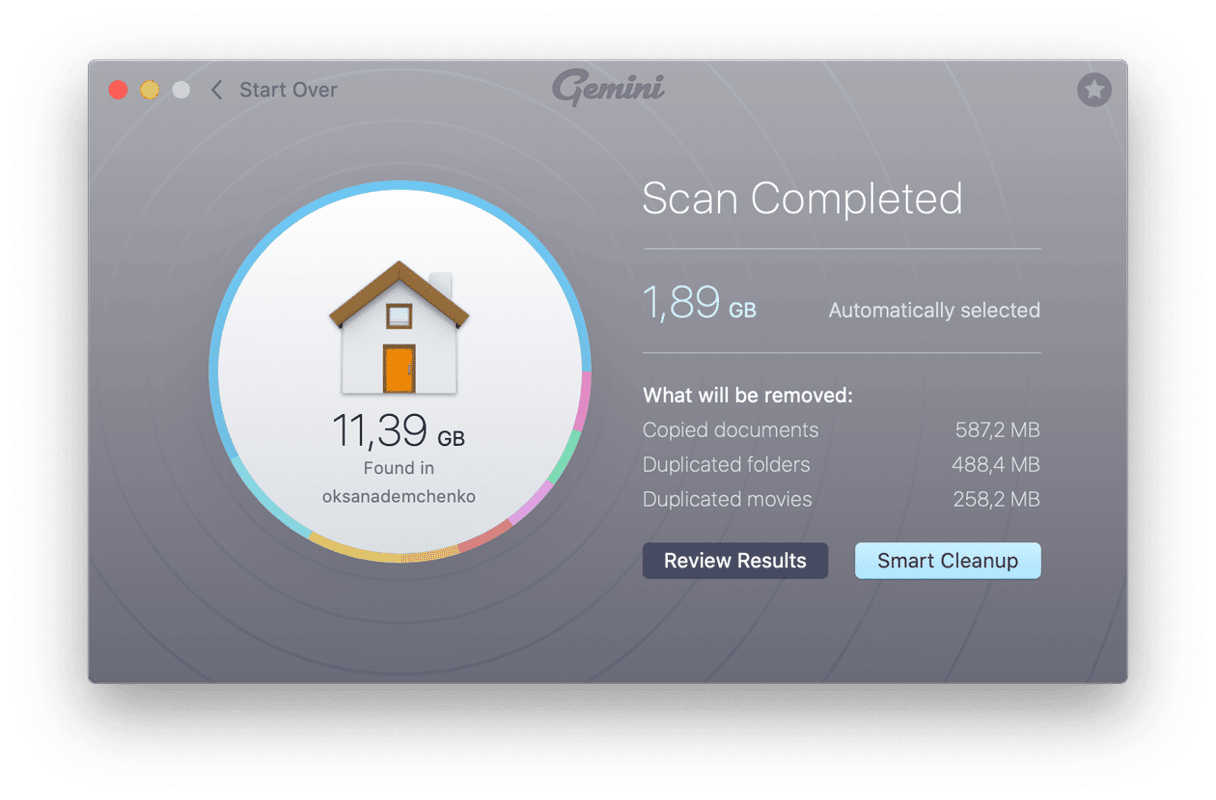Whether you’ve just taken a weekend trip up North or the European vacation of your dreams, you’re guaranteed to return home with a massive amount of photos, probably a handful of videos, and, if you were feeling particularly artsy, half a dozen time-lapses.
But now that you’re home, what are you going to do with all those pictures? Where are you going to keep them? How are you going to share them?
Enter the Photos app for Mac.
What is Photos on Mac?
The Photos app is a convenient home for all of your pictures and videos. Anything you shoot, Photos will store it and — better yet — organize it, so you can actually find said pictures when you feel like reliving the memories.
In this post, we’ll go over the basics of using Apple’s Photos app. We’ll talk about where to find photos on your Mac and how you can manage your ever-growing photo library. And of course, we’ll cover all the features Apple has built into this underrated app.
iPhoto vs Photos: What’s the difference?
Those of you familiar with iPhoto for Mac are probably wondering what makes its successor so special. And to oversimplify it, Photos is the next step in photo management — and a giant step at that.
Prior to Photos, Apple made two apps for managing pictures and videos. iPhoto, for those of us less experienced in photography, and Aperture, for the ones looking to do some heavier editing. Photos perfectly blurs the line between those two apps, combining the best of both while adding new features like iCloud Photo Library and iCloud Photo Sharing.
If you used iPhoto before, Photos will feel instantly recognizable. You’ll have your pictures, albums, and collections in the main window, a navigation sidebar to the left, and different viewing options at the top. However, a significant point of difference between iPhoto and Photos is the app’s performance. When working with larger libraries, iPhoto had the tendency to lag or choke up and had arbitrary limits that would restrict album and collection sizes. Photos gets rid of those limitations entirely and is able to handle much larger libraries than its predecessor. While the look of Photos may be the same, it feels like a faster and more powerful app.
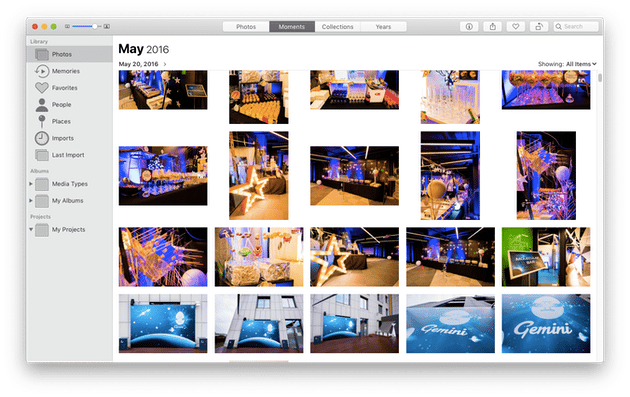
How to manage photos in iPhotos
iPhoto is designed to make managing your pictures incredibly easy. Here are a couple of iPhoto features you should know:
Albums. It’s a quick and easy way to keep an assortment of photos together. You can keep things organized by location, person, or project.
Events. When you import pictures into iPhoto, it will look at the timestamp, or when you took each picture, and try to organize them by “events”. Whether it’s a party or a vacation, I’m sure you’ll find events are a great way to search for pics.
Folders. You might be wondering, “what’s the difference between an album and a folder?” That’s simple. Folders organize your albums and albums organize your photos. Instead of having one massive album, you can have multiple and store them in a folder.
Tags. This feature alone could vastly improve your iPhoto experience. Adding tags or keywords to your pictures will help you find your pictures so much faster when you’re looking for them.
While those are just a few helpful features built into iPhoto, they all have their limitations. Especially if your library is cluttered with duplicates and similar-looking pictures that you don’t actually want anymore. But, fortunately, you can use Gemini 2 to help you scan for duplicates and quickly get rid of them.

How to use Apple’s Photos app
When you open Photos for the first time, the app offers you a glimpse of what your library will look like with all your pictures and videos imported. You get a quick intro to some of the features and tools, and learn how you can make these memories tangible through printed objects like calendars, photo books, and more.
Once you’ve finished the tour of the app and gone through the initial setup, you’re all set to start importing your pictures and videos!
How to import photos to Mac
There are several ways you can import your media content to Photos, depending on where you’ve been storing it.
From your iPhone or a digital camera
- Connect your iPhone or camera to your Mac with a USB cable. You might need to unlock your iPhone with your passcode, and then tap Trust when prompted to Trust This Computer.
- On your Mac, if the Photos app doesn’t open automatically, go ahead and open it.
- The Photos app will show you an Import screen that has all the photos and videos on your iPhone or camera. If you don’t see the Import screen, click on your iPhone or camera in the Photos sidebar under Devices.
- From here you can either choose to Import All New Items or select a batch and click Import Selected.
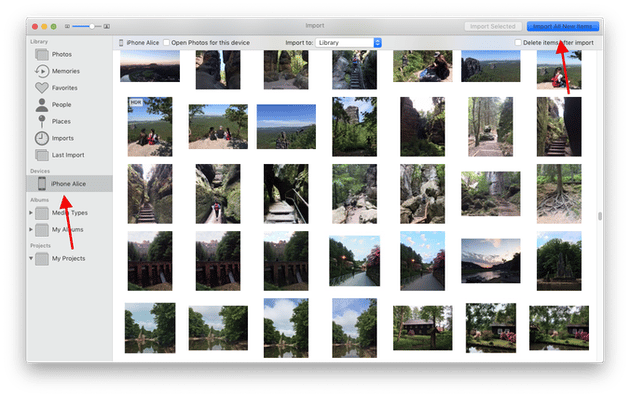
From a folder or an external hard drive in Finder
You have a couple of options here. If your pictures and videos live on an external hard drive, you’ll want to make sure it’s connected first. Then, you’ll want to do one of the following:
- Drag the files from your drive into the Photos window
- Drag the files from your drive onto the Photos icon in the Dock
- In Photos, go to File > Import from the menu bar. Choose the photos or videos you want to import and click Review for Import.
An important thing to know about Photos is that the app copies the pictures and videos into the Photos Library we talked about earlier, leaving the original file either on your device or in its folder.
Tabs in Photos: Library, Albums, Projects
Have you ever been unable to find a specific picture because you couldn’t remember when you took it? You can remember everything else about the photo, things like where it was taken and who was in it, but not the one thing you need to navigate your files.
The Photos app helps you with this predicament by organizing your pictures not only by date, but also by event, location, and even by people’s faces. In the sidebar, you’ll find a number of tabs designed to make sorting through your pictures easier.
Memories. Photos creates “memories” based on who is in a series of images as well as when and where those pictures were taken.
Favorites. These are the pictures you’ve gone through and clicked the heart icon on, marking them as your favorites.
People. This is where you’ll be able to see all the pictures of you have of specific people.
Places. This is where you can see all the pictures you’ve taken in specific locations.
Shared. This section is where you’ll find all the albums you’ve shared with other people and the albums that have been shared with you. (Check out our guide to iCloud Photo Sharing for more info on Shared Albums.)
Albums. If you want to group certain pictures for easy navigation, you’ll want to create a new album. This section is where you can access those albums.
How to tag people in photos
If you want to tag someone in a specific picture:
- Open the photo in the Photos app
- Click the info button in the top right corner.
- At the bottom of the info window, you’ll see circles with faces at the bottom. Tap on one of those.
- The face will now be circled on the photo. Underneath the circle will be a text box labeled “unnamed.” Click on the text box and type the person’s name.
If the person you’re tagging has already been tagged in your Library, their name should appear under the circle on the photo.

How to add a title, description, and keywords to a picture in Photos
Photos does a great job at scanning your pictures and identifying key features in them to make searching easier and faster. But sometimes, adding your own information can make it even better. That's because how you would describe it will likely be how you'd try to search for it later.
Here's how you add a title, description, or keywords:
- In Photos, select the picture you want to add information.
- Press Command + I. The Info window will open.
- Click "Add a Title" and type in your title.
- Click on "Add a Caption" and give your picture a description.
- Then, click on "Add a Keyword" and type some words that'll help you find it later.
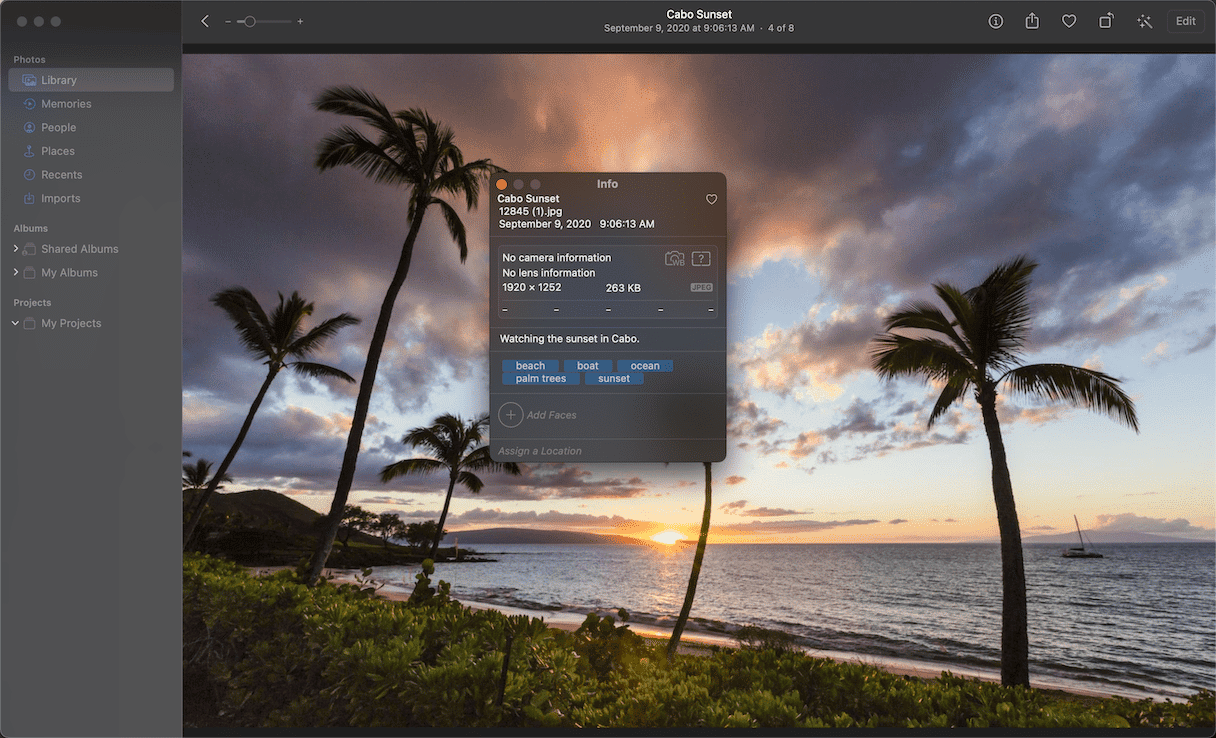
How to manage keywords in Photos app
If you're trying to be more consistent with your keywords and not have to type them in for every picture, Photos has an easy way to manage them.
- With Photos open, press Command + K to open the keyword window.
- Select any picture.
- Then, select the keywords you want to add.
Note: You can remove a keyword by clicking on it again.

If you want to add a keyword that isn't already there, just click Edit Keywords > +.
How to search for your pictures and videos in Photos
Earlier you read about how Photos will scan your pictures for identifying elements, and now you know how to add titles, descriptions, and keywords. So, how do you search for a specific image? Searching for pictures is just as easy as tagging your photos if you follow these steps:
- In the top right corner, click on the Search bar.
- Type in search terms like you would for an internet search.
- Double-click on the photo you were looking for.
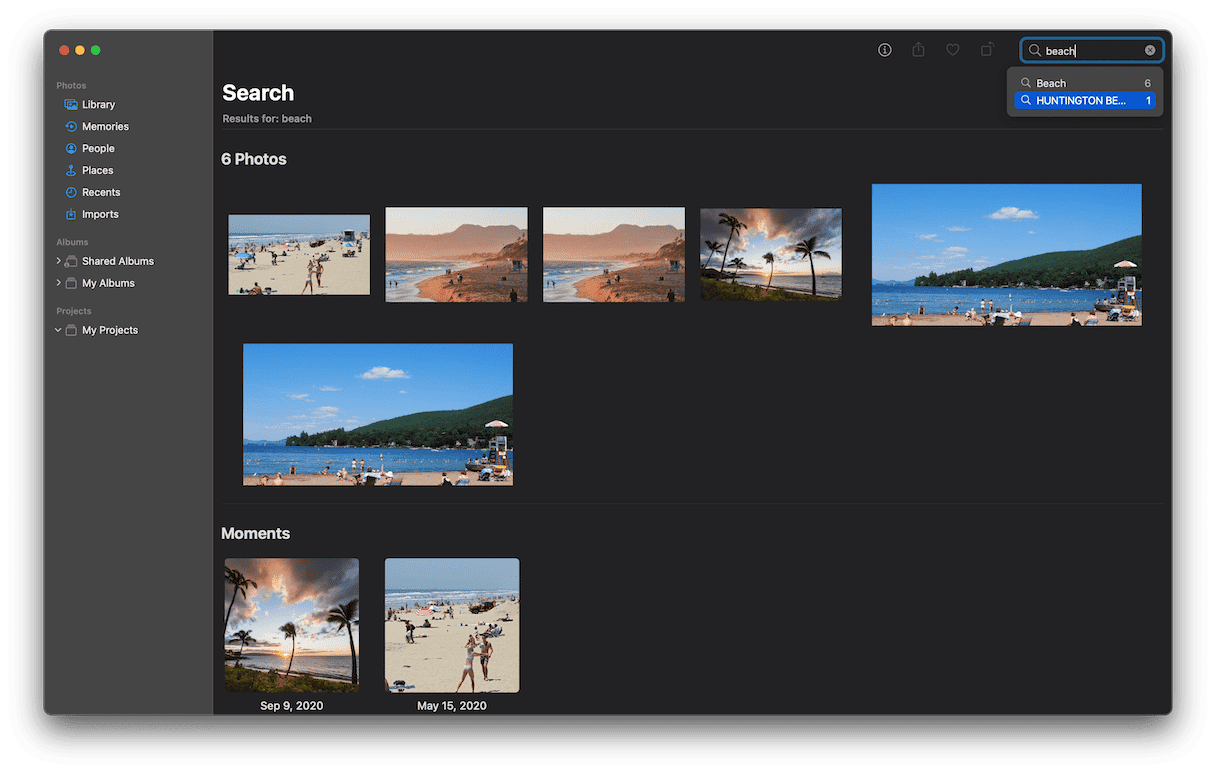
How to use Smart Albums
If you've ever used a Smart folder in Finder, then you'll be very familiar with how Smart Albums work. But if you haven't, then simply put, Smart Albums will save the results of a search—so, for instance, all of your "beach" photos are stored in a Smart Album. That way, you can always go back to them without having to search for them, and as you import more new pictures, they can be added to the Smart Album if they fit your search criteria.
To create a new Smart Album in Photos, just follow these steps:
- Click File > New Smart Album.
- Give it a name and set your search criteria.
- Then, click Ok.
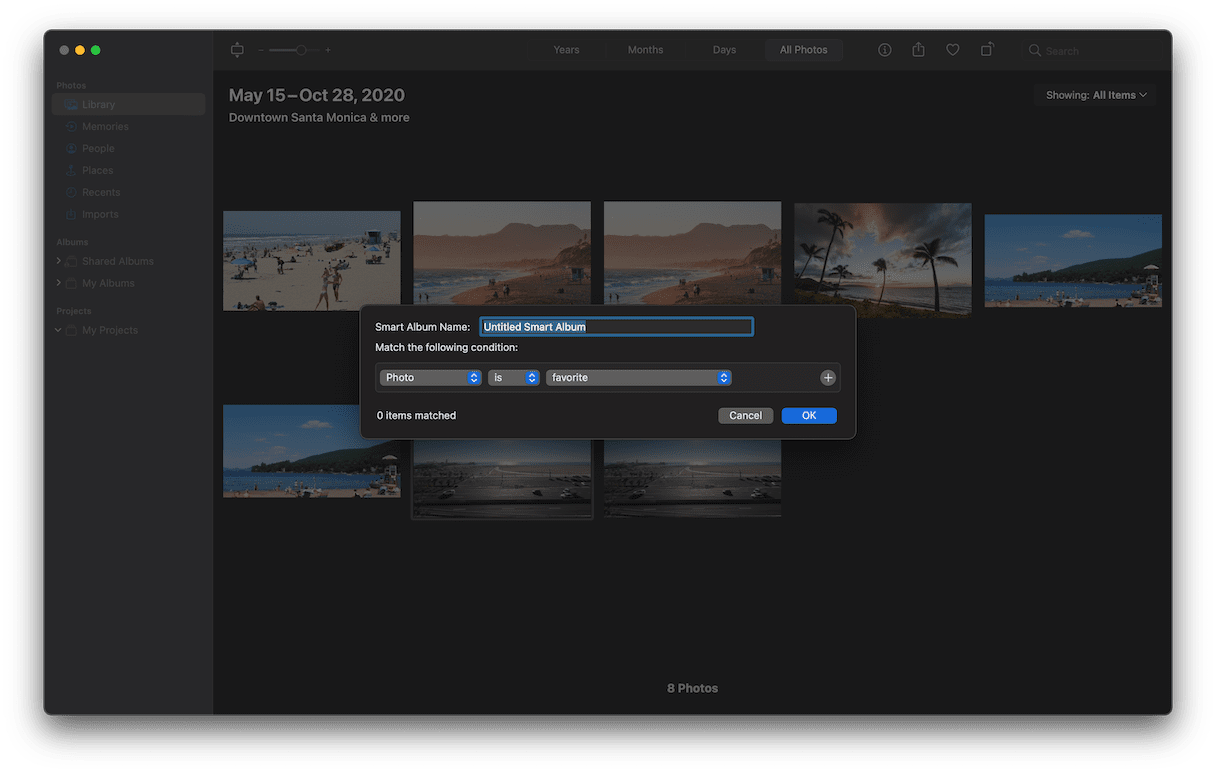
Edit with Photos
Another really great feature of Photos is all of its editing capabilities. You can do everything from simple crops or rotations to drastic color adjustments. Or even just add a preset filter to one of your pictures. For a ton more information on using Photos to edit your pictures, check out this article.
Now that you’ve gotten a feel for how to use Photos on Mac, it’s time to give it a spin. Once you’ve got your library set up and organized, you’ll see how easy it is to relive and share your memories with Photos.



